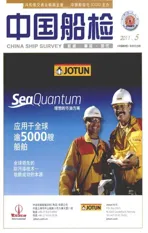黄金水道解“锁”密码
2011-05-26
本刊记者 徐 华
黄金水道解“锁”密码
本刊记者 徐 华

2011年3月,交通运输部发布了《关于贯彻国务院关于加快长江等内河水运发展的意见的实施意见》,标志着我国加快内河水运发展进入实施阶段。然而,一个不容忽视的现实是,在航道整治驶上快车道的同时,诸如桥梁、闸坝等碍航状况更显突出。二律背反规律表明,任何局部或环节最优往往会损害系统整体的利益,长江各方涉水因素,都在有形或无形地影响着长江通航能力的综合发挥。
跨江大桥再拔高
长江通江达海、水量充沛,有优良的航运条件。1931年,美国万吨级“加利福尼亚”油轮曾自长江口直达武汉。然而,现在万吨级船舶要实现江海直达更多地要看桥梁的脸色了。凌空飞架的桥梁使万吨级海轮的长江之旅只能浅尝辄止。
目前,我国长江干线跨河桥梁有60座之多,其中江通长江大桥、江阴长江大桥等5座大桥净空在32米以上,可通过万吨级海船外,其它均在24米以下。其中,中下游通航净高度普遍为24米,共有11座,一般可通过5000吨级单船或万吨级船队。中上游桥梁的通航净高度普遍为18米,共有41座,一般可通过3000吨级船队。造成我国跨江大桥净空普遍过低的主要原因是最早建成的南京、武汉长江大桥净空为24米,其后的桥梁都错误地参照了这个标准,例如黄石、九江、铜陵等桥梁。其净空尺寸远小于压载时万吨船舶吃水线到桅顶高度。正是跨江桥梁净空参考标准过低,导致桥梁在沟通南北交通时,却卡住了长江东西水运。
从这一点来看,美国密西西比河流域开发则更加注重保证航运的通航要求。自圣路易斯以下到河口1600公里的河段仅建两座大桥,平均800公里一座。众多的跨江桥梁,大都在河流上游和支流。密西西比河上下7座大桥有6座均在47米以上,海轮可上行到距河口4056公里处。
由于建成桥梁限制,南京至铜陵213公里可供万吨级海轮通航的深水航道未得到充分利用。国家自上世纪80年代以来,先后投资数十亿元在芜湖、安庆、九江、黄石、武汉、城陵矶、重庆等港口建成的数十座5000吨级外贸码头和集装箱码头,却很少有大型外轮靠泊。桥梁净空过低成为长江中上游广大地区出海物流大通道的瓶颈。
据交通运输部总工程师徐光介绍,研究表明,万吨级海船直达安庆是较为经济合理的运输范围,首先,航道自然条件和建设可能性大。目前,安庆以下航道通过治理具备在枯水期达到6米水深的条件,中洪水期基本满足万吨级海船通航要求。安庆以上枯水期只能达到4.5米水深,继续提高航道水深技术上存在很大难度。其次,水路运输组织的经济规律性最优。与中转运输相比,海船直达虽然减少中转换装环节,但海船造价和航行成本相对较高,到一定范围后,直达不具有成本优势。经测算,在回程货装载率达到30%以上时,万吨级海船直达安庆相对中转运输具有经济合理性。综合考虑,安庆以下是万吨级江海直达相对合理的范围。
那么,从长江航运的长远看,安庆以下桥梁就有必要考虑提高跨江大桥的跨度和净空标准。例如通过技术改造,提高现有桥梁尤其可适宜万吨海轮河段桥梁的净空高度。据专家介绍,目前提高桥梁高度有几种方法:一是加高桥墩,抬高桥梁;二是改造大桥,使其中一个桥孔提升为活动桥。莱茵河上就有一些桥梁采取这种方法;三是建造适应现行桥梁跨度的大型标准船舶。例如,2007年9月21日,从宁波港出发首航到武汉钢铁工业港的“江夏文”号万吨级货轮,桅杆可以收起。另外,还可以将船舶驾驶台建造成为可升降形式,以便控制过桥时船舶的高度。
三峡枢纽能力效率齐升级
三峡工程具有防洪、发电、航运等综合效益。然而,自从1997年大江截流以来,长江干线航运却走过了一断不寻常的坎坷之路。从明渠到临时船闸,三峡的通航能力始终明显不足。为了解决这一问题,1998年,翻坝过闸开始出现。这作为当时三峡建设中的临时之举实为无奈。然而,2003年6月15日,三峡双线五级船闸投入运行,长江航运正常通航之后,翻坝却依然担负着大量的过闸物资转运的重要作用。
据报导,三峡船闸自2003年6月16日投入试运行以来,虽然通过科研和实践摸索不断改进船闸调度与管理,船闸通过量有所提高,但是由于船闸实际通过能力2460万吨与设计能力5000万吨存在较大差距,难以实现快速过坝,船舶滞留时有发生。在船闸开始运行的半年中,在两线船闸正常运行期间,有一定数量船舶滞留待闸,最高达252艘。尤其是在坝区流量超限、枢纽冲沙、客运高峰、船闸应急抢修和计划性停航期间,大量待闸船舶在三峡坝区滞留,最高达349艘。
目前,据官方数据显示,2008年,三峡船闸运行8661闸次,通过55351艘次,通过货运量5370万吨,翻坝运量1477万吨,过坝货运量合计6847万吨。三峡船闸待闸时间4~10小时,过闸时间约3.5小时。三峡下行过闸货运量和下行过坝货运量分别为3259万吨和4013万吨,是三峡船闸设计通过能力的65%和80%。据有关研究机构预测,2020年、2030年三峡枢纽断面下行货运量将分别达到6315万吨、7750万吨。而三峡船闸设计单向通过能力为5000万吨。从长远看,即使考虑今后三峡升船机投入使用,三峡现有通航建筑物也难以满足船舶过坝需要。
在《长江三峡水利枢纽初步设计报告(枢纽工程)》中,已经提到当三峡工程通航建筑物不能满足通航需要时,要考虑建设新的过船通道。三峡工程五级船闸于1994年4月开工,2003年6月试通航,2007年5月船闸工程全面竣工,工程建设前后历时13年。加上规划、勘测、科研和设计时间,三峡船闸建设经历的时间更长。在三峡通航建筑物通过能力不能满足通航需要前,应预先研究并建设三峡大坝新的船舶通道,并应留足工程建设前期工作时间和建设时间。
据了解,目前三峡新船闸的建设方案已经进入了研究阶段,而先期被停建的三峡升船机已于2008年9月开始续建,金属结构制造安装正在招标,计划在2015年6月建成运行。同时,三峡翻坝公路也正在建设之中,有专家指出,提高三峡枢纽综合通过能力和翻坝运输效率,应该调整原来的“水-陆-水”为“水-陆”运输方式,目前,长江右岸正在建设翻坝运输高速公路,该公路上起姊归曲溪桥,经过姊归县、夷陵区等,止于宜昌长江公路大桥南岸,连接沪渝高速公路,全长57.38公里,于2010年底建成。同时,翻坝码头也正在紧锣密鼓地建设中。三峡坝上右岸已建码头有茅坪港客运码头、靖江溪滚装码头,左岸有太平溪港客运码头、姊归物流中心滚装码头。两坝间已建码头包括右岸岱狮滚装码头,左岸杨家咀滚装码头,黄柏河水域平湖滚装码头和夜明珠滚装码头。
据统计,2009年,通过三峡枢纽断面货运量7425万吨,其中通过船闸6089万吨,翻坝运输1336万吨。预测2020年通过三峡枢纽断面货运量约1.3亿吨,其中通过船闸和升船机1.1亿吨,翻坝运输2000万吨。

水库群联合调度
长江上游干支流是我国水电能源集中地区,金沙江、雅砻江、乌江、岷江、大度河、嘉陵江等干支流陆续进行了水电建设开发,结合已经建成的三峡、葛洲坝水利枢纽,长江干支大型水库群将陆续形成。
由于长江上游干支流水库分属不同业主管理,大都按单库运行方式或某一支流级水库联合运行方式运行,这将制约三峡工程和上游水库综合效益综合的发挥。专家建议长江干支大型水库群应进行联合调度,从而更合理地安排水库群的蓄、泄水时机,协调兴利与防洪、生态的关系。同时,上游水库群联合调度后,梯级水库可进行补充调节,三峡水库可较长时间维持在高水位运行,枯水期对下游补偿量增大,航道水深增加,对保障航运效益的正常发挥将起到较好作用。
当然,水库蓄水给库区航道带来益处的同时,在长江干支流的高等级航道中,水库群依然碍航断航现象也不容忽视。细数下来,令人痛心。在乌江上,除彭水外其余梯级未同步建设通航设施,造成断航。沅水航道规划为500吨级,但白市、托口梯级升船机为通航50吨船舶,洪江梯级通航设施为300吨级。挂治梯级未建通航设施。汉江,丹江口升船机无法正常运行。赣江通航规划为1000吨级,但万安梯级通航设施为500吨级。信江的界牌枢纽蓄水位未达设计标准,造成船闸坎上水深不足,同时红卫坝枢纽未按要求拆除。钱塘江航道规划为500吨级,富春江船闸只能通过100吨级船舶。
多年来,闸坝碍航,与跨江桥梁净高过低一样,是长期困扰着内河航运的典型性问题,已成为长江通过能力的硬伤。既然是硬伤就很难在朝夕之间就可以解决,然而,硬伤背后所反映的,更多的是软环境的不足所带来的直接后果。在长江大力加快提高航道等级的同时,长江船舶的通过能力要切实找到着力点,还需要更多内河软实力的提升。

In March 2011, the Ministry of Transport issued “Advice on implementation of the State Council’s Opinions on accelerating the development of inland water transport including Yangtze River”, marking that China has started to put into practice the development plan. However, a fact that can not be ignored is that impeding navigation problems such as bridges and gate dams will be more outstanding when speeding up waterway dredging.
Elevating cross-river bridges without suff i cient headroom
Yangtze River fl ows into the East China Sea and thanks to its abundant water received from tributaries and lakes,was navigable by ocean-going vessels. In 1931, the 10,000-ton US tanker “California” made her way up to Wu Han directly from its mouth. At present, however, vessels of ten thousand tons intending to make a river-sea voyage are subject to the height of cross-river bridges.allow the ship of 3,000 tons to pass through. Due to the restriction of built bridges, the 213km deep water route from Nanjing to Tongling, which is navigable by sea-going vessels of 10,000 tons, has not been fully utilized. Too low headroom under bridges has become the bottleneck of thoroughfare for sea logistics from the middle and upper reaches of Yangtze River.
Currently, there are more than 60 cross-river bridges along Yangtze River Trunk Line, among which 11 bridges in the middle-lower reaches of the river usually have net height of 24 meters for navigation, and could allow the ships of 5,000 tons or 10,000 tons to pass through, while 41 bridges in the middle-upper reaches of the river usually have net height of 18 meters for navigation, and could
According to Xu Guang, Chief Engineer of Chinese Ministry of Transport, the study has shown that the economically reasonable transport route for sea-going vessels of 10,000 tons is direct navigation up to An Qing.Consequently, the long-term development of Yangtze River shipping requires elevation of the spanning and headroom standards for the newly built river-crossing bridges from An Qing down to the lower reaches of the river. According to experts, currently there are several methods of raising the height of bridges .Firstly, heighten piers to raise the bridge girder. Secondly, renovate bridges to turn one of apertures of the bridge into movable bridge. Some bridges over the Rhine have adopted this method. Thirdly, turn road and rail dualpurpose bridges into dedicated road service bridge, and dismantle sublayer bridge for railway service to increase the headroom. In addition, large standard vessels to be built should accommodate existing bridges’ span.
Upgrading capacity and efficiency of three gorges project
The Three Gorges project has multiple benefits ranging from flood prevention to electricity generation and shipping. However, since the damming of the great river in 1997, the shipping on Yangtze River Trunk Line has gone through all kinds of trials and tribulations. From open channel to temporary lock, Three Gorges has obvious def i ciencies in terms of navigation capacity. To solve this problem, the phenomenon of passing through the dam by road started to appear in 1998, which was a temporary action due to lack of alternative during construction of Three Gorges. However, even though the two-way fivestep lock of Three Gorges put into service on 15thJune,2003 and Yangtze River was open to normal navigation,the means of passing through the dam by road still played an important role in transferring a large amount of goods and materials.
From the long term perspective, the existing navigation buildings of Three Gorges are diff i cult to meet the demand of ships to pass through the dam, even considering the future use of ship lift. At present, the earlier suspended construction of Three Gorges ship lift began to be resumed from September 2008. The bidding for metal structure and manufacturing installation is in the process,and the ship lift is planned to be completed and put into service by June 2015. Meanwhile, Three Gorges roads used for transferring goods are also under construction.Some experts point out that the original transportation mode of “water-land-water” should be adjusted to “waterland” by increasing the overall transit capacity of Three Gorges Dam and improving the efficiency of passing through the dam by road. According to the statistics, the cargo volume passing through Three Gorges section was 74.25m tons in 2009, of which 60.89m tons passed through ship lock and 13.36m tons by transferring to road.It is predicted that the cargo volume of Three Gorges section will reach 130m tons by 2020, of which 110m tons will pass through ship lock and lift and 20m tons by transferring to road.
Consolidated management of reservoir group
Main streams and tributaries of the upper Yangtze River give rise to China’s major water and hydroelectric resources. Jinsha River, Yalong River, Wujiang River,Minjiang River, Dadu River and Jialing River successively started hydroelectric constructions, which, together with Three Gorges and Gezhouba Dam that have been built,will lead to gradual formation of large reservoir groups in the main streams and tributaries of the Yangtze River.
Since the reservoirs in the main streams and tributaries of the Yangtze River belong to different owners, most of them are being run in the form of single reservoir or joint reservoir operation in the same tributary, which will restrict the overall efficiency of the Three Gorges project and upstream reservoirs. Experts suggest that the reservoir groups in main streams and tributaries of the Yangtze River should be managed in union, so that the timing of water storage and fl ood discharge could be scheduled more reasonably, and the relations among water conservancy, flood control and ecology could be coordinated. Meanwhile, when reservoir groups in the upper reaches implement joint management, step reservoirs could be replenished and regulated, the Three Gorges reservoir could maintain its operation at high water level for a extended period and thus increase water supply to the lower reaches in dry seasons, and the depth of navigation route could also be increased, all of which will help promote shipping eff i ciency of the river.
Decoding the“Locked” Golden Channels
Reporter Xu Hua
